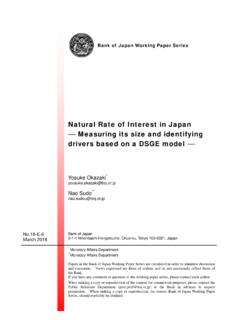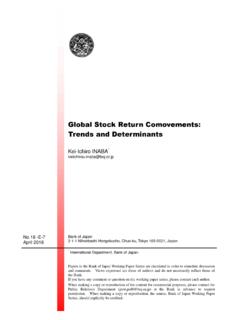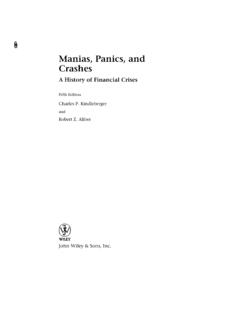Transcription of Economic Activity, Prices, and Monetary Policy in Japan
1 NAKAMURA Toyoaki Member of the Policy Board Bank of Japan Februar y 9, 2022 (English translation based on the Japanese original) Economic Activity, Prices, and Monetary Policy in Japan Speech at a Meeting with Local Leaders in Yamanashi (via webcast) 1 I. Economic and Price Developments at Home and Abroad A. Recent Developments and Outlook for Economic Activity and Prices I will begin my speech by talking about recent developments in Economic activity and prices. Overseas economies have recovered on the whole, albeit with variation across countries and regions, with the impact of the novel coronavirus (COVID-19) waning gradually (Chart 1).
2 In advanced economies, resumption of Economic activity continues as vaccination has progressed, while priority public health measures have been taken to respond specifically to the spread of the Omicron variant. Emerging and commodity-exporting economies have generally picked up on the back of progress with vaccinations. Against this background, a pick-up in Japan 's economy has become evident (Chart 2). Exports and production continue on an uptrend, albeit with the effects of supply-side constraints. A pick-up in private consumption has also become evident since early autumn 2021, although downward pressure due to the spread of the Omicron variant has recently been a cause for concern.
3 On the price front, the year-on-year rate of change in the consumer price index (CPI) for all items less fresh food, or core CPI, despite being affected by the reduction in mobile phone charges, has been slightly positive, reflecting price rises in energy and other items (Chart 3). Japan 's economy is likely to recover as the impact of COVID-19 and the effects of supply-side constraints gradually wane. The year-on-year rate of change in the core CPI is also likely to increase in positive territory due to a dissipation of the effects of a reduction in mobile phone charges on the back of a moderate pass-through of raw material cost increases.
4 B. Risk Factors for Economic Activity and Prices This outlook is subject to a number of uncertainties; specifically, I am particularly attentive to the following factors. The first is the Chinese economy, sometimes referred to as "the world's market" or "the workshop of the world." There is a risk that the spread of the Omicron variant under China's zero-Covid Policy will lead to globally prolonged supply-side constraints and protracted 2 inflationary pressures, in addition to pushing down the global economy. Attention should also be paid to such factors as the aging population, intensified conflict between China and both the United States and Europe, and the decline in medium- to long-term growth potential mainly due to the imposition of stronger restrictions.
5 The second factor is firms' price-setting behavior. Uncertainties surround future developments in the pass-through of raw material cost increases, leaving potential for movement in either direction. If cost increases are not passed on sufficiently, this could cause firms to fall into a vicious cycle where their business performance will deteriorate, making it inevitable that they will cut wages and investment for the future. On the other hand, the pass-through of cost increases may also proceed further than expected; firms have recently become increasingly sensitive to inflation, with upstream price rises gradually spreading to downstream (Chart 4).
6 I consider it crucial for firms' price-setting stance to become active in order for Japan 's economy to shift toward a new growth path and to achieve the Bank's price stability target. The third factor is a change in households' preference for holding on to their cash and deposits. The amount outstanding of households' cash and deposits continued to grow, increasing by 44 trillion yen relative to the pre-pandemic trend, and reaching 1,072 trillion yen as of end-September 2021 (Chart 5). If the impact of COVID-19 gradually wanes, this is expected to result in a materialization of pent-up demand, thereby stimulating Economic activity.
7 In fact, with the younger generation in particular having been showing greater interest in financial asset investment, it is hoped -- as I will elaborate on later -- that if households can reap the fruits of global Economic growth by gaining stable income through the dividends from their investment in financial assets, this will help bring about a virtuous cycle of growth and distribution in the long run. At the same time, these trends naturally weaken when households lower their growth expectations for Japanese firms. I am therefore paying close attention to how these trends develop alongside firms' efforts toward achieving growth.
8 The fourth factor is investment behavior, particularly among small and medium-sized enterprises (SMEs). The amount outstanding of cash and deposits has been on an increasing trend for both large enterprises and SMEs. In contrast, net interest-bearing debt -- the 3 difference between interest-bearing debt and cash and deposits -- has been decreasing as a trend among SMEs, unlike large enterprises, showing no clear increase since 2018 (Chart 6). Shifting our focus to business fixed investment for fiscal 2021, large enterprises across all industries have been in line with past averages, maintaining a 9 percent-plus increase over the previous fiscal year.
9 In contrast, the Bank of Japan 's December 2021 Tankan (Short-Term Economic Survey of Enterprises in Japan ) shows that business fixed investment for SMEs across all industries, which tends to be revised upward through the fiscal year-end, has been relatively weak (Chart 7). Attention should be paid to whether SMEs strengthen their stance of cutting investment and hoarding cash and deposits, as this will delay a long-standing challenge to Japan 's economy, namely, raising productivity. II. Conduct of Monetary Policy Let me now turn to the Bank's Policy conduct. The Bank has conducted powerful Monetary easing in response to COVID-19 since March 2020 through the following three measures: (1) the Special Program to Support Financing in Response to the Novel Coronavirus (COVID-19); (2) an ample and flexible provision of funds; and (3) purchases of exchange-traded funds (ETFs) and Japan real estate investment trusts (J-REITs).
10 The Bank's responses have had positive effects, coupled with the government's measures and active efforts by financial institutions, and financial conditions in Japan have been accommodative on the whole. That said, weakness remains in the financial positions of firms in some segments, such as the face-to-face services industry, and of small and medium-sized firms. There also continues to be significant uncertainty surrounding the impact of COVID-19, including the spread of the Omicron variant. Against this background, the Bank decided in December 2021 to extend the Special Program in part by six months with a view to doing its utmost to support financing, mainly of small and medium-sized firms (Chart 8).










